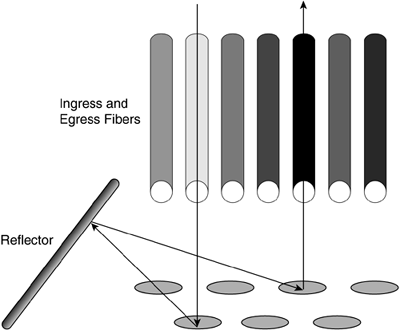DWDM
Dense Wave Division Multiplexing (DWDM), allows providers to enable services such as e-mail, video, and multimedia to be carried as IP data over ATM and voice carried over SONET/SDH. Despite these formats providing unique bandwidth management techniques, all three IP, ATM, and SONET/SDH may be transported over the optical layer using DWDM.
DWDM works by combining and transmitting multiple signals simultaneously at different wavelengths on the same fiber. In effect, one fiber is transformed into multiple virtual fibers. Eight OC-48 signals are multiplexed into one fiber, increasing the carrying capacity of that fiber from 2.5 Gbps to 20 Gbps. DWDM is protocol and bit-rate independent, meaning that DWDM-based networks can transmit data in IP, ATM, SONET, and Ethernet and handle bit-rates between 100 Mbps and 2.5 Gbps.
DWDM increases the capacity of existing fiber by assigning incoming optical signals to specific frequencies, or wavelengths (lambdas), and then multiplexing these signals into a single signal on a single fiber. Because incoming signals are never terminated in the optical layer, the interface is bit-rate and format independent; for example, IP, Ethernet, SONET, and so on.
DWDM contains multiple optical signals that are amplified as a group and transported over a single fiber increasing capacity. Each signal can carry different rates, such as OC-x (OC-3, OC-12, OC-48, etc.), and in a different format SONET, ATM, and so on. Current DWDM systems can achieve capacity of over 40 Gbps, with future developments carrying 80 wavelengths of OC-48 (2.5 Gbps), totaling 200 Gbps, or 40 wavelengths of OC-192 (10 Gbps), totaling 400 Gbps.
The ITU has standardized channel separation of DWDM wavelengths at 100 GHz, although more vendors today are using 50 GHz or less to separate the wavelengths, yielding more capacity across the fiber.
DWDM Technology
The high-speed, high-volume transmission of DWDM is achieved by the optical amplifier. Optical amplifiers operate in a specific band of the frequency spectrum and are optimized for operation with existing fiber, making it possible to boost lightwave signals, extending their reach without converting them back to electrical form.
DWDM systems consist of multiple input lasers, LTE multiplexer, transport fiber, LTE demultiplexer, and receiving laser diodes. A DWDM system is illustrated Figure 22-5.
Figure 22-5. DWDM Concept

DWDM wavelengths are assigned a different frequency, or color, across the spectrum, with a minimal amount of frequency spacing between the "colored" wavelengths.
DWDM Capacity
The following table reflects current and future trends of DWDM implementations and the bandwidth enabled by each implementation.
Wavelength | Timeline | Capacity |
|---|---|---|
DWDM at OC-192 and 40l | Current | 40 wavelengths at 100 Ghz spacing, at 10 Gbps each, totaling 400 Gbps. |
DWDM at OC-192 and 80l | Current | 80 wavelengths at 50 Ghz spacing, at 10 Gbps each, totaling 800 Gbps. |
DWDM at OC-768 and 40l | Current | This is current in that developmental work is being performed today. 40 wavelengths, at 40 Gbps per wavelength, totaling 1.6 Tbps (Terabits-per-second). |
DWDM at OC-768 and 80l | Future | (2002) 80 wavelengths totaling 3.2 Tbps. |
DWDM at OC-192 and 160l | Future | (2005) 160 wavelengths (with closer spacing) at 10 Gbps, totaling 1.6 Tbps. |
DWDM at OC-768 and 160l | Future | (2008-2009) 160 wavelengths at 40 Gbps, totaling 6.4 Tbps. |
Technical Note: Optical SwitchingTraditional electronic-based switching systems convert the wavelength from optical-electronic-optical; this conversion is not an ideal scenario because the electronic conversion process limits bandwidth capacity. Optical switching does not perform this conversion because all signals are "light," without any electrical signal conversion. Optical switching is a light-based form of a digital cross-connect. The digital cross-connect system, sometimes referred to as a Digital Access and Cross-Connect Systems, or Digital Cross-Connect System (DACS or DXC), is a switch designed to establish long-term "nailed-up" circuit paths. Micro Electrical Mechanical Systems (MEMS) is the switching technology that Lambda (l)-based systems use when deploying optical-based switching and routing devices. The following figure illustrates how MEMS performs optical switching. MEMS relies on micron-mirrors, which can be configured at various angles to ensure that incoming lambdas hit one fixed mirror, reflect from a movable mirror (Reflector) back to another fixed mirror, and then reflect back out another lambda. |
Cisco Note: Cisco Optical Product Suite NoticeCisco Systems announced the end of sales (EoS), end of life (EoL), and end of support for the Cisco ISR 3303/Cisco ONS 15303/4. The product is no longer orderable, and the support for the ISR 3303/ONS 15303/4 will end January 18, 2004. The Cisco ONS 15327 Metro Edge Optical Transport Platform is the recommended product to replace the Cisco ISR 3303/Cisco ONS 15303/4. The Cisco ONS 15327 delivers SONET, integrated optical networking, unprecedented multiservices on demand, and radical economics to the edge of metro networks. This platform enables the deployment of next-generation services more rapidly than traditionally available. In addition to the Cisco ONS 15327 and ONS 15454, Cisco offers an entire line of metro optical products including the Cisco ONS 15200 Metro DWDM family, the first solution to deliver instant wavelengths to buildings, premises, or points of presence (PoPs). |
Figure 22-6. MEMS

EAN: 2147483647
Pages: 269